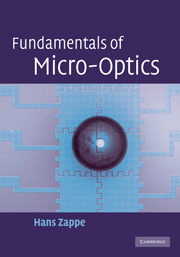5 - Interferometry
from Part I - Essential optics
Published online by Cambridge University Press: 05 June 2012
Summary
In my model, important interference phenomena arise when individual strata come into contact. These chaotic fluctuations are, I suppose, what my music is really ‘about’.
B. Ferneyhough, 1996Interference is one of the most important phenomena in optics, and forms the basis for diffractive optics, one of the most relevant subdisciplines of micro-optics. Interference effects result from the superposition of electromagnetic fields with closely matched frequency, and explain many naturally observed phenomena, such as the colorful rings generated by thin oil films on wet surfaces. For the optician interference is a tool useful both for the development of novel optical components and for high-accuracy measurement tasks.
This chapter begins by considering coherence and interference in general, and then focuses on interferometers, optical systems that take advantage of interference effects for determination of distances, wavelengths, refractive indices, and a host of related parameters. Interferometers are not only essential characterization tools for micro-optics, but are also fabricated using the technologies of micro- or integrated optics to realize a wide variety of measurement tasks. We then turn to the optics of thin-film multilayers, optical coatings on surfaces that rely on interference to generate customizable transmission or reflection properties. By depositing layers of precisely controlled refractive index in layers at the correct thicknesses, the interference of partially transmitted and partially reflected fields can generate high or low reflection, or, for example, filters that transmit only a certain band of wavelengths. The design and fabrication of anti-reflection coatings are important process steps in the manufacture of both macro and micro-optical components.
- Type
- Chapter
- Information
- Fundamentals of Micro-Optics , pp. 125 - 166Publisher: Cambridge University PressPrint publication year: 2010



